Skip takeout tonight, and make some flavor-packed lo mein for dinner, right in your kitchen!
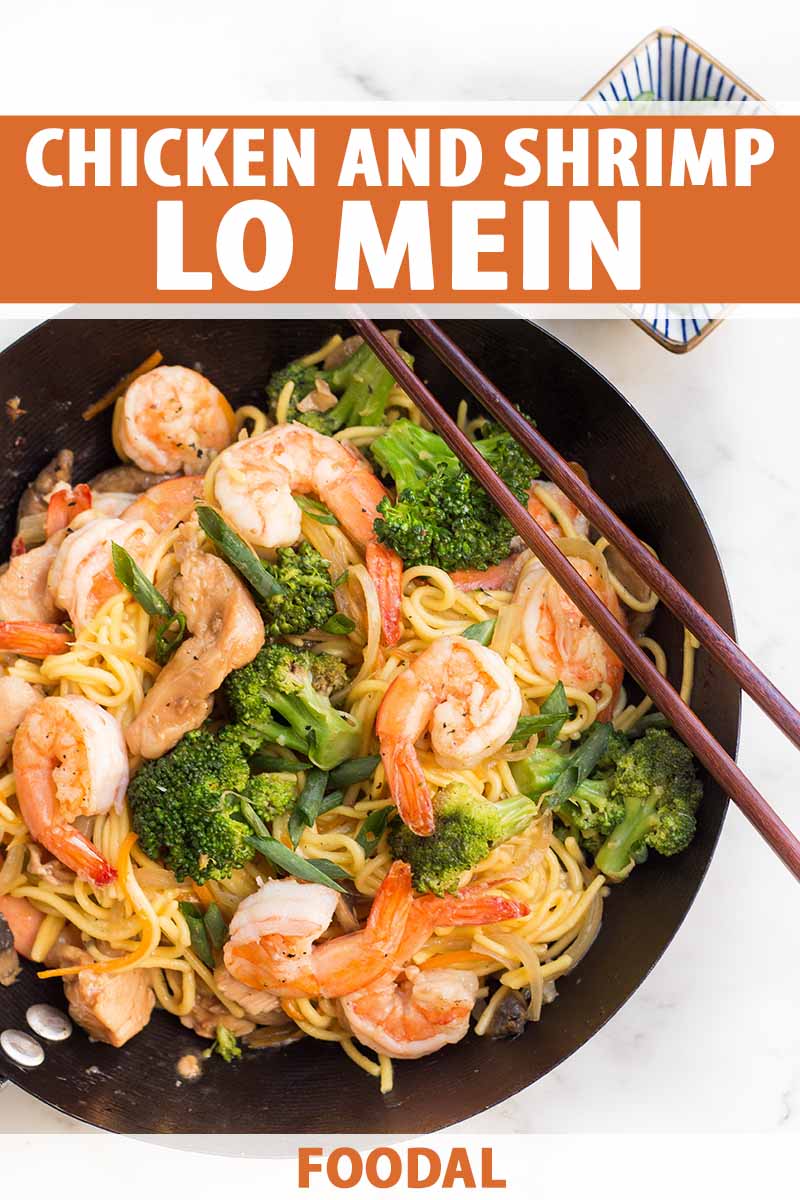
This version of lo mein is loaded with a tasty variety of proteins and vegetables.
It also uses less noodles per total volume than most lo mein recipes, so you get heartier servings of vegetables, chicken, and shrimp.
Follow our recipe and use our helpful tips and tricks to enjoy perfectly cooked lo mein with stir-fried chicken strips, shrimp, and lots of veggies – all seasoned with the wonderful flavors from both a marinade and a sauce.
Before heating up your wok, read our strategies below for the ultimate guide to making the best lo mein meal… no restaurant necessary!
Perfect Prep – The Secret to Quick and Awesome Meals at Home
If there is a secret to making good meals quickly at home that are inspired by your favorite restaurants, it is having everything ready before you start cooking. This is particularly helpful to make fast chicken dishes!
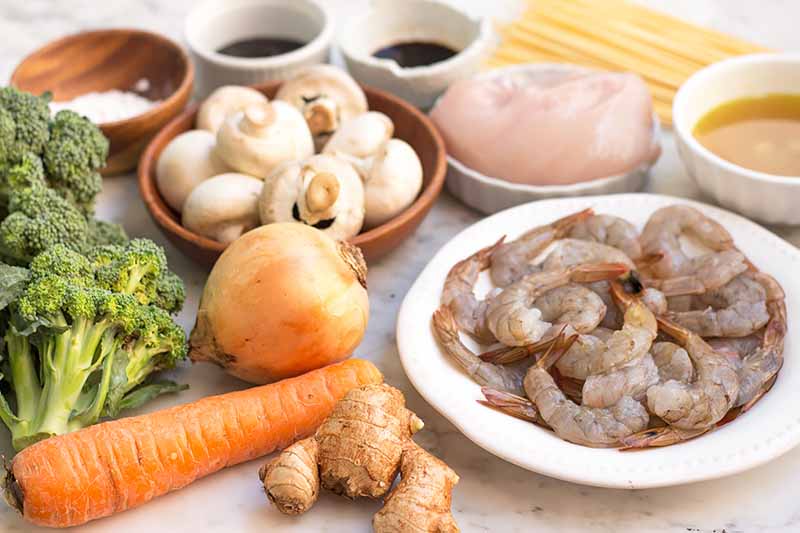
While this recipe might read like it involves a lot of prep work and cleanup, it’s not bad at all. And you’ll be so happy with the results!
You can save some time in the following ways:
- Prepare the Mise en Place: Prep your mise en place by gathering all of the ingredients and tools as the very first step of the cooking process.
- Slice and Stir: While the noodles are cooking, you can slice the meat and prepare the marinade and sauce.
- Use Convenient Ingredients: Using frozen mixed vegetables or frozen peeled and deveined raw or pre-cooked shrimp saves time without compromising the final product.
- Clean As You Go: Cleaning as you go while you are cooking saves time as well, and helps to avoid domestic strife!
Sauces, Spices, and Stocks – Get the Best and Boldest Flavors
Only a few basic spices and sauces are needed to create dishes with big and bold flavors at home.
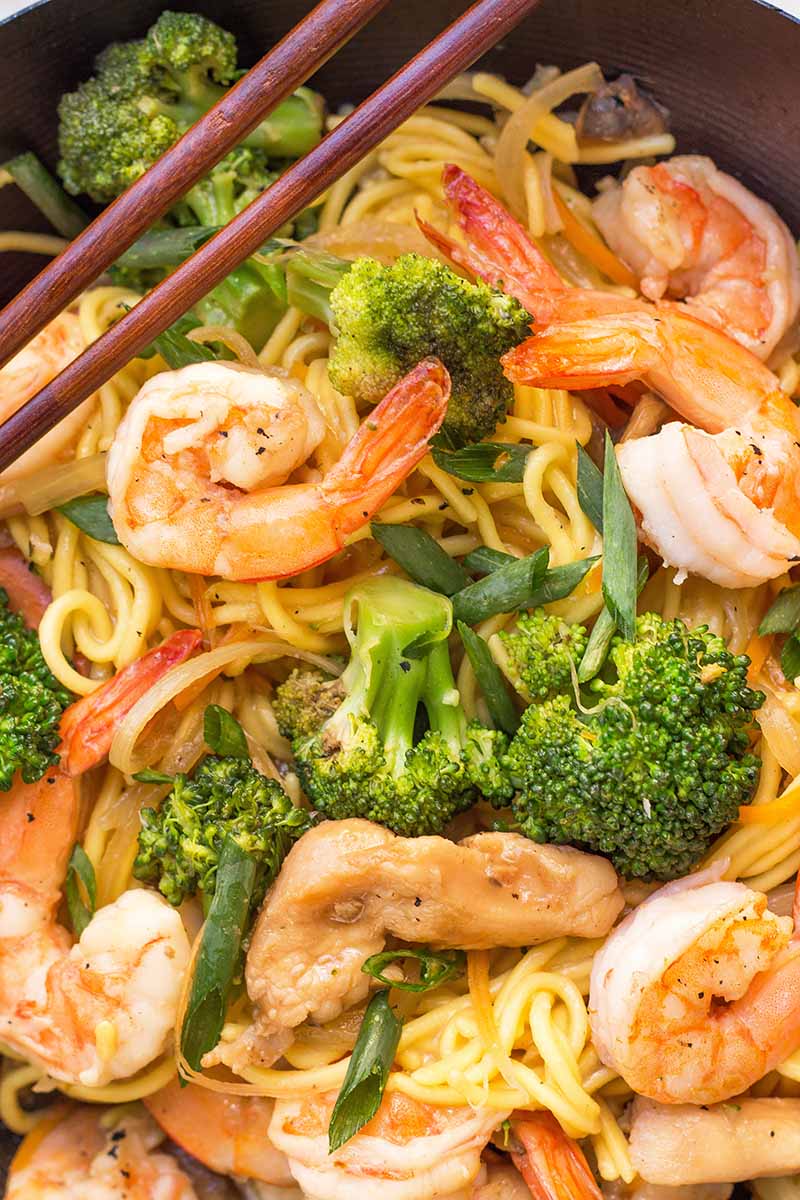
Soy sauce, ginger, and oyster sauce are absolute essentials to make this recipe really shine, in my opinion.
Many consider oyster sauce to be optional, but the flavor and aroma it adds really gives the impression that you know what you’re doing.
Add some rice vinegar – white vinegar would work, too – as well as some freshly cracked salt and pepper towards the end of the cooking process to taste and you’re ready for a tasty meal!
Salt is not included in the sauce recipe, since the stock, soy, and oyster sauces are quite savory and very salty on their own. Before adding the noodles, you can taste the sauce and add salt if desired.
We use stock as a conveniently available addition to mix in to slightly thin out the sauce while adding flavor.
Use a store-bought chicken stock product, or use your own supply if you recently made our recipe for slow cooker stock.
You could also substitute beef stock for the chicken in this recipe, if you prefer its slightly meatier flavor. But if you want to enhance the seafood flavor, opt for homemade seafood stock instead.
For a sauce that’s lighter in flavor, use less stock and replace the missing volume with an equal amount of water.
Vegetables – Endless Options to Veggie-Fy Your Stir-Fry
Part of the beauty of this recipe is that it is very flexible, particularly with what vegetables you decide to use.
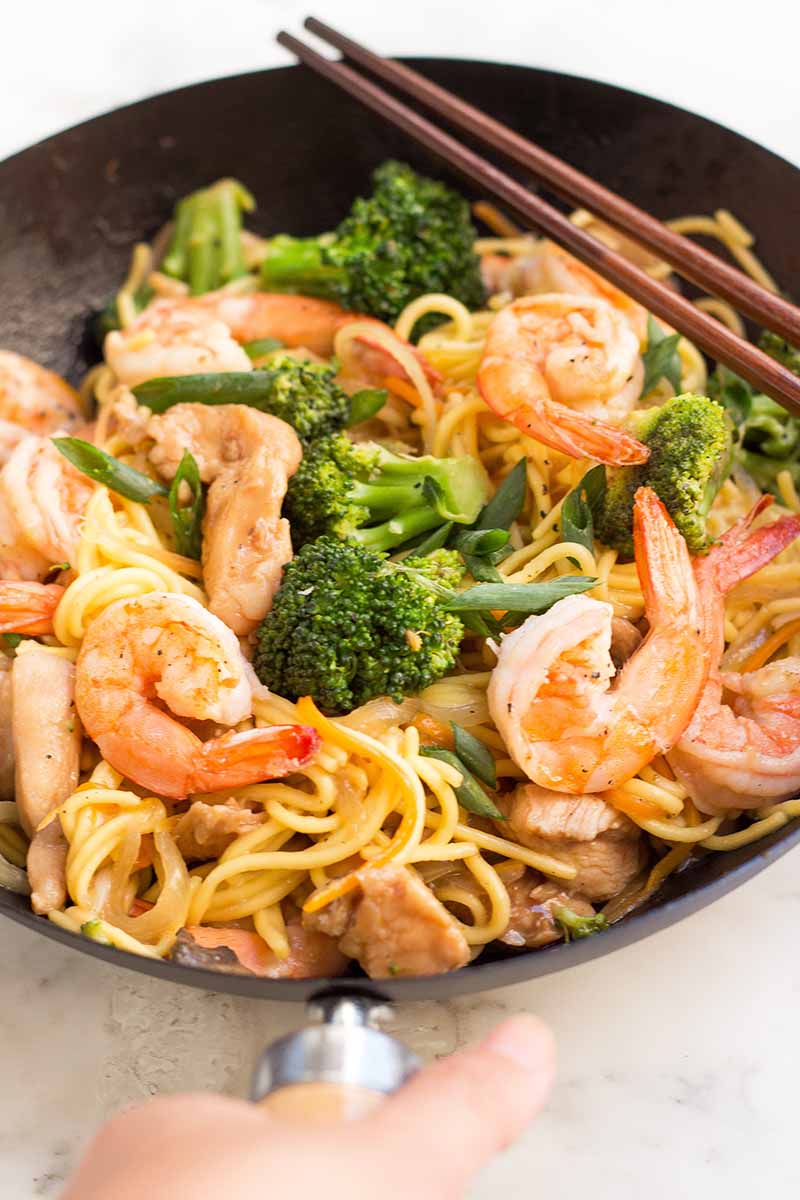
And because you’re mixing everything with a super savory, totally delicious sauce, you might even fool the family into eating more veggies than expected!
Measurements in the recipe below are approximate, and can be adjusted based on what you have on hand.
You can use either fresh, frozen, or a combo of both.
If you decide to use all fresh vegetables, equal parts mushrooms, snow peas, and broccoli, plus some diced onion, makes a good mix.
Frozen veggies work in a pinch – you can finally use those long-forgotten bags of mixed veggies in your freezer that you bought on sale months ago!
I normally cheat a bit here and use mainly frozen vegetables, but I recommend also adding some fresh snow peas and mushrooms to help you to hide this time-saving solution. Frozen vegetables may be soft upon defrosting and cooking, so the addition of a few crisp, fresh vegetables will help to improve the texture.
Oodles of Noodles – Other Options to Consider
The lo mein noodle, a long, soft variety made with wheat flour and eggs, may not be your favorite.
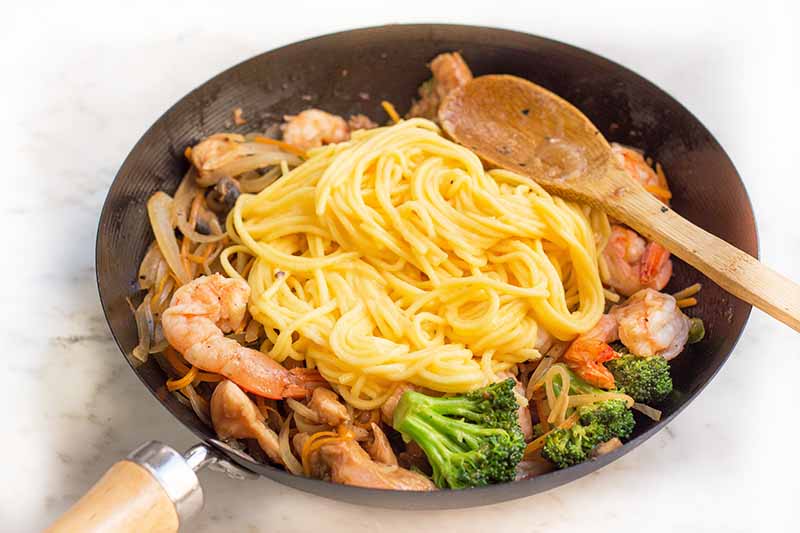
No worries– there are plenty of other options!
If you follow a gluten-free diet, vermicelli rice noodles,, cellophane noodles made with potato or bean starch, or spiralized vegetables like zucchini or sweet potatoes will be perfect substitutes. You can also swap the soy sauce, which contains wheat, with an equal amount of gluten-free tamari.
You could also search the international section of your local grocery store, or take a trip to the Chinese grocer to see all of the fun selections of assorted noodles available there. There is usually an entire section dedicated to various noodle products, fresh and dried.
Buy one, or a few different kinds to try something new.
Just be sure to follow the cooking directions provided by the manufacturer to ensure you cook them properly.
Ready? Let’s Wok!
Now that we’ve outlined all of the advice you’ll need on how to make our recipe for chicken and shrimp lo mein with assorted veggies, you’re more than ready to get in the kitchen!
Keep on reading for the recipe and our step-by-step Cooking by the Numbers guidelines.
Print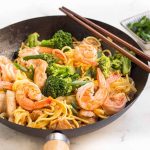
Chicken and Shrimp Lo Mein
- Total Time: 45 minutes
- Yield: 4 servings 1x
Description
Making lo mein at home is easy to do. With our recipe, you can serve a flavorful mix of noodles, shrimp, chicken, and veggies in under an hour.
Ingredients
For the Marinade:
- 1/2 teaspoon cornstarch
- 2 tablespoons soy sauce
- 2 tablespoons oyster sauce
- 1/4 teaspoon freshly cracked black pepper
- 1 tablespoon rice wine vinegar
For the Lo Mein:
- 6 ounces chicken breast, sliced
- 8 ounces Chinese egg noodles
- 5 tablespoons vegetable oil, divided
- 1 small head broccoli, cut into florets
- 2 cups sliced fresh mushrooms
- 1 cup julienned carrots
- 1 cup sliced onions
- 6 ounces raw shrimp, peeled and deveined
For the Sauce:
- 1 1/2 tablespoons cornstarch
- 1 tablespoon soy sauce
- 1 cup chicken stock
- 1 tablespoon oyster sauce
- 1 teaspoon gently packed light brown sugar
- 3/4 teaspoons freshly grated ginger
- 1/4 teaspoon freshly ground black pepper
Instructions
- Prepare the marinade. Place the cornstarch, soy sauce, oyster sauce, black pepper and rice wine vinegar in a large bowl. Stir well until combined.
- Place the sliced chicken in the bowl with the marinade, and use your hands to massage the chicken with the marinade until the meat is well coated. Let it soak for at least 25 minutes, or up to 3 hours, in a covered container in the refrigerator.
- In a small bowl, prepare the sauce by combining the cornstarch, soy sauce, chicken stock, oyster sauce, brown sugar, ginger, and black pepper. Stir, then set aside.
- While the chicken is marinating, cook the noodles according to the package instructions. Drain the noodles and then rinse them with cool tap water, and toss with a little vegetable oil to prevent clumping. Set aside.
- Place a wok on high heat and add 2 tablespoons of oil, swirling it around to coat the sides of the pan. When the oil is hot to the point of smoking, remove the chicken strips from the marinade and place in the pan. Discard the marinade. Cook the chicken for about 2 minutes, stirring constantly, until just cooked through. Remove from the wok and set aside.
- Add and heat another tablespoon of oil if the wok seems dry. Stir fry the broccoli, mushrooms, carrots, and onions, stirring constantly with a wooden spoon for about 5-8 minutes until the onions are translucent. Add 1/2 cup of water, cover, and steam for 3 minutes. Set the cooked vegetables aside.
- Bring another 1/2 cup of water to a boil in the wok, and use a wooden spoon or spatula to deglaze the pan. Pour off the liquid and wipe the wok dry with paper towels. Return the wok to the heat, add 2 tablespoons of oil, and swirl the wok to coat the sides with oil.
- When the oil heats up to the point of smoking, add the shrimp. Let the shrimp cook on one side until it turns pink before flipping it over to cook the other side, about 30 seconds to 1 minute per side.
- Return the chicken and vegetables to the wok, and toss to combine with the cooked shrimp.
- Create a well in the middle of the ingredients and pour the sauce in, then stir well until the sauce thickens, keeping it relatively confined to the well in the center of the pan. Add the cooked noodles to the well and coat them with the sauce, using chopsticks or a fork to toss and separate them if they are sticking together.
- Stir to combine all ingredients, and serve immediately while hot.
- Prep Time: 15 minutes
- Cook Time: 30 minutes
- Category: Chicken
- Method: Stir-Fry
- Cuisine: Chinese
Keywords: chicken, shrimp, stir-fry, lo mein
Cooking by the Numbers…
Step 1 – Set Out Your Mise en Place
First, gather and prepare all of your ingredients.
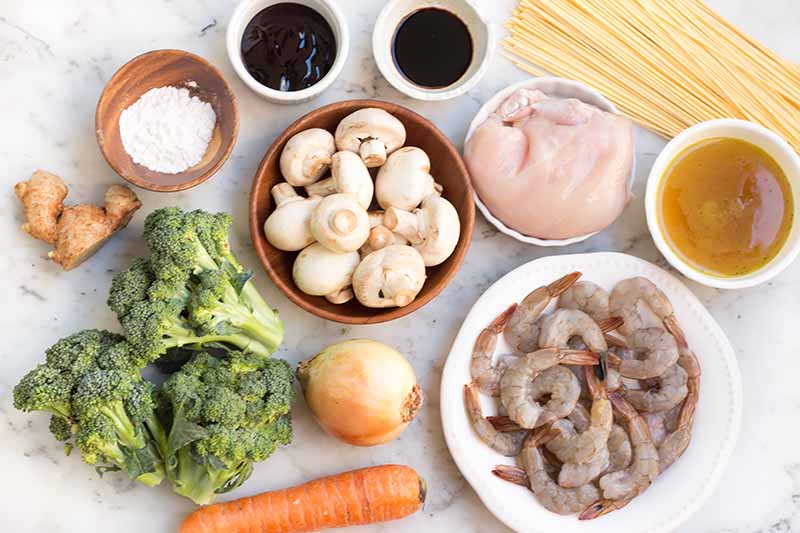
Measure out all of the ingredients for the marinade: the cornstarch, soy sauce, oyster sauce, freshly cracked black pepper, and rice wine vinegar.
Measure or set out all of the ingredients for the lo mein: the chicken breast, egg noodles, vegetable oil, vegetables, and shrimp.
Measure out all of the ingredients for the sauce: the cornstarch, soy sauce, chicken stock, oyster sauce, light brown sugar, and freshly cracked black pepper. Freshly grate the ginger with a microplane or grater.
Set out your wok and any preferred utensils.
If you do not have a wok, a large frying pan can also work – but a sturdy wok really is an excellent item to have on hand for making stir-fries! Choose from the preferred selections of woks in our review.
Step 2 – Marinate the Chicken and Devein the Shrimp
Combine the cornstarch, soy sauce, oyster sauce, black pepper, and rice wine vinegar to make the marinade in a large bowl. Mix well.
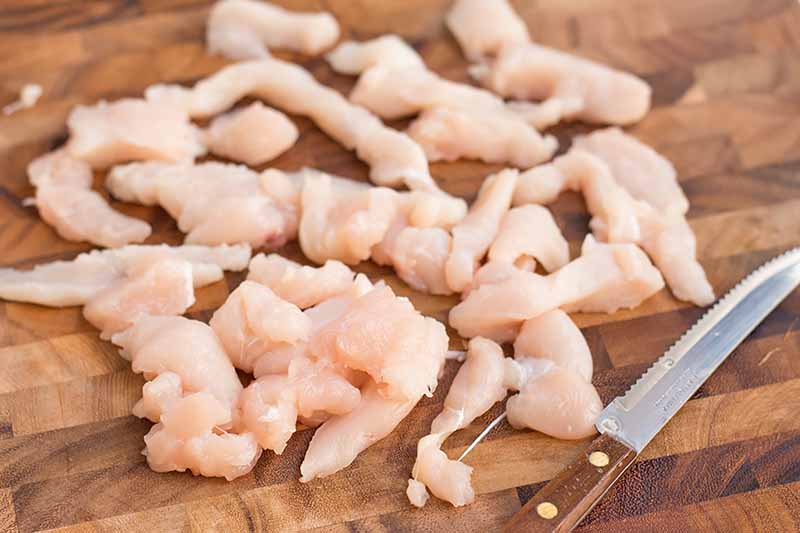
On a clean cutting board, trim away any fat with a paring knife as needed, and cut the chicken breast into thin, three-inch-long strips.
Coat the chicken strips in the prepared marinade, massaging it in to coat each piece.
Cover the bowl with plastic wrap and let the meat marinate for at least 25 minutes in the refrigerator.
While the chicken is marinating, you can complete all of the other prep steps. Start with a fresh, clean cutting board, and be sure to wash your hands after working with raw chicken.
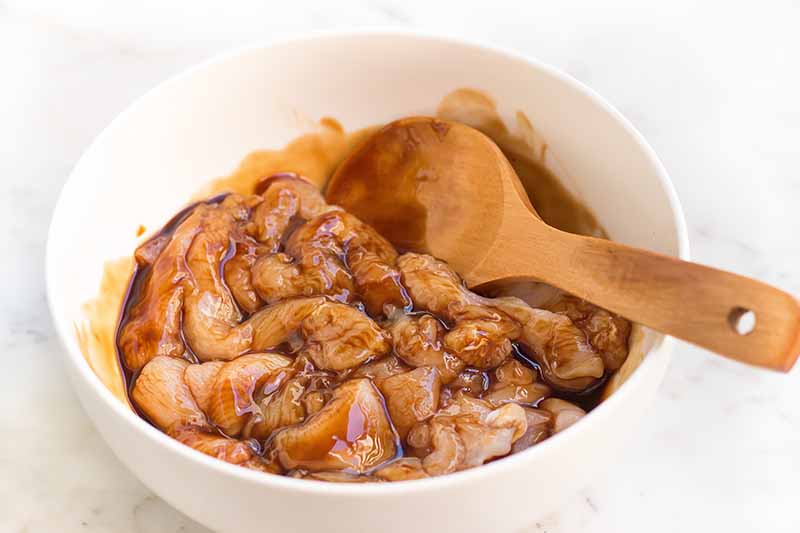
Devein the shrimp if necessary. Not sure how? Check out our helpful guide to peeling and deveining shrimp!
If using frozen raw or pre-cooked shrimp, be sure to safely thaw it prior to cooking according to the package instructions. This typically involves briefly rinsing or soaking the shrimp in a bowl of cold water for a few minutes until just defrosted.
Step 3 – Prepare the Vegetables
Rinse and dry all of the vegetables.

Cut the broccoli into bite-sized florets, discarding the stems or saving them for another use. Prep the mushrooms by removing the stems and cutting them into thin slices.
Peel the onions and then slice them thinly.
Peel the carrots and julienne them into thin noodles. I like to use a julienne peeler to do this, but you could also use a mandoline or sharp chef’s knife.
Peel the ginger, and grate it for the sauce.
Step 4 – Make the Sauce
To make the sauce, combine the cornstarch, soy sauce, chicken stock, oyster sauce, brown sugar, grated ginger, and freshly ground black pepper.
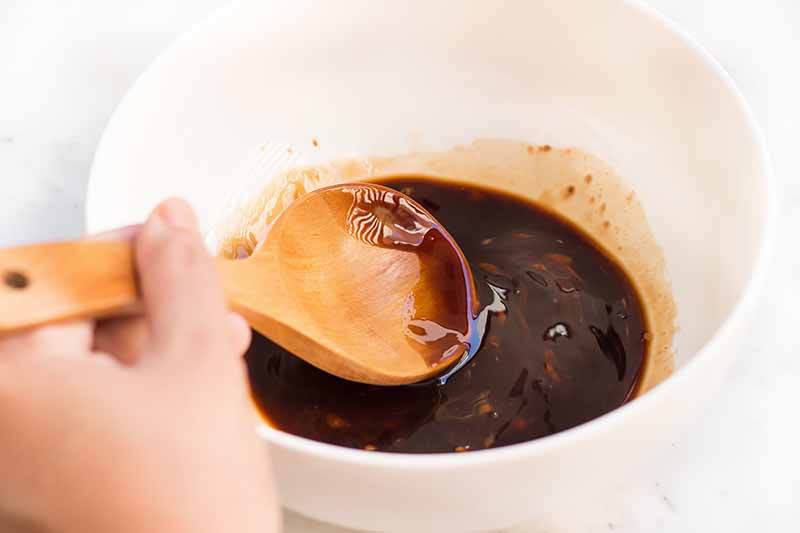
Mix well and set aside.
Step 5 – Cook the Noodles
As the chicken continues to marinate, cook the noodles according to the package instructions.
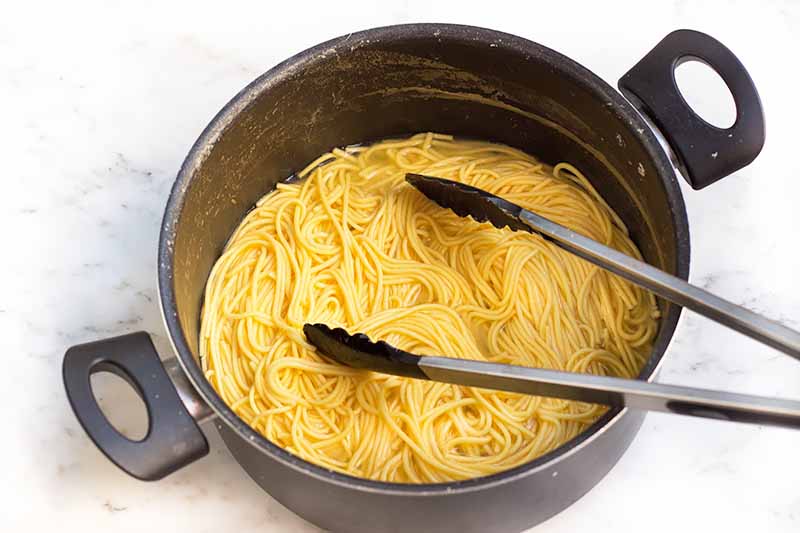
Once they are cooked, drain them immediately and rinse them under cold tap water in a colander to prevent them from cooking further.
Toss the noodles with a drizzle of vegetable oil to prevent them from clumping together, then set them aside.
Step 6 – Cook the Chicken
When the meat is done marinating, heat up your wok and coat the sides with 2 tablespoons of vegetable oil.
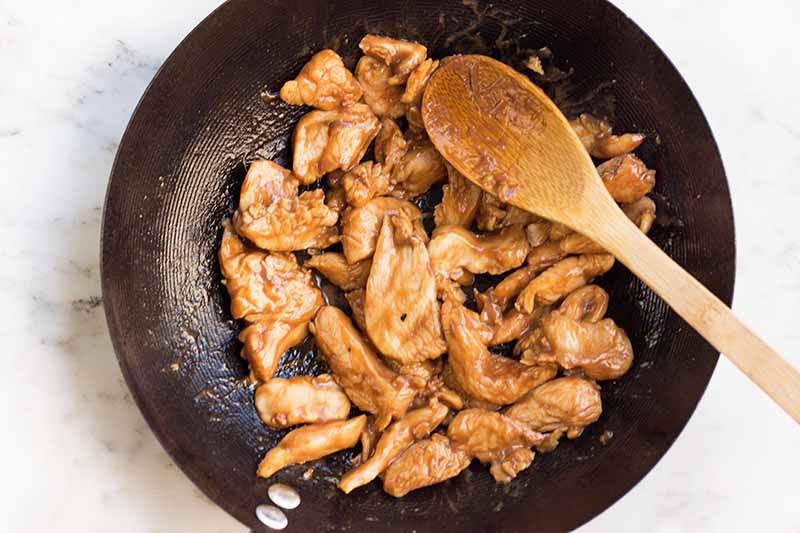
Once the oil is heated to the point of smoking, remove the chicken from the marinade and add it to the wok. Discard the marinade. Toss the chicken constantly with a wooden spoon for a few minutes, until it’s cooked through.
You can check its doneness in two ways: either with a meat thermometer that registers 165°F when inserted in the thickest piece, or by slicing the thickest piece in half and seeing if the meat is completely white and cooked through.
Remove the chicken from the wok and set it aside.
Step 7 – Stir-Fry the Vegetables
If the chicken soaked up too much of the oil, add and heat another tablespoon of oil in the wok.
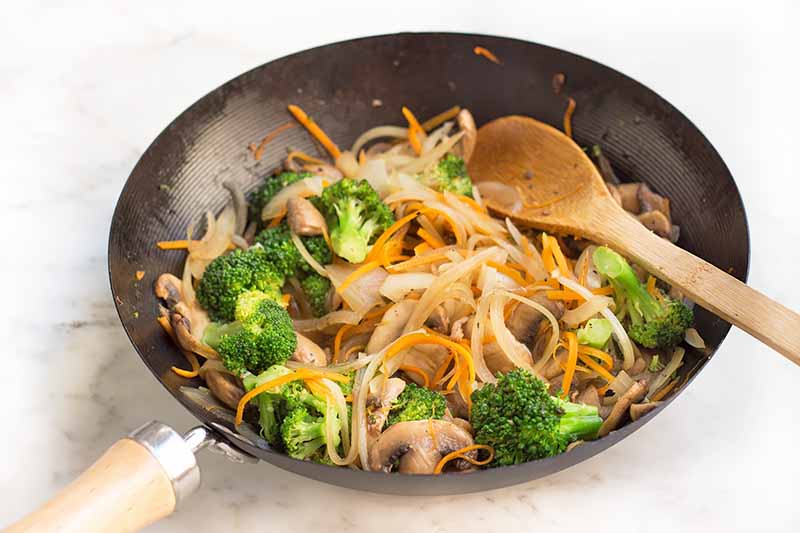
Stir-fry the broccoli, onions, mushrooms, and carrots for about 5 to 8 minutes, or until the onions are translucent and the carrots and broccoli are crisp-tender.
If using frozen vegetables, you do not need to defrost them prior to cooking. You can add them directly to the wok in this step.
Add 1/2 cup of water and cover the wok with a lid to let the vegetables steam for about 3 minutes. Remove from the pan and set the vegetables aside.
Step 8 – Deglaze and Cook the Shrimp
Bring another 1/2 cup of water to a boil in the wok and use a wooden spoon to deglaze the pan. Discard the liquid and wipe out the wok with paper towels.
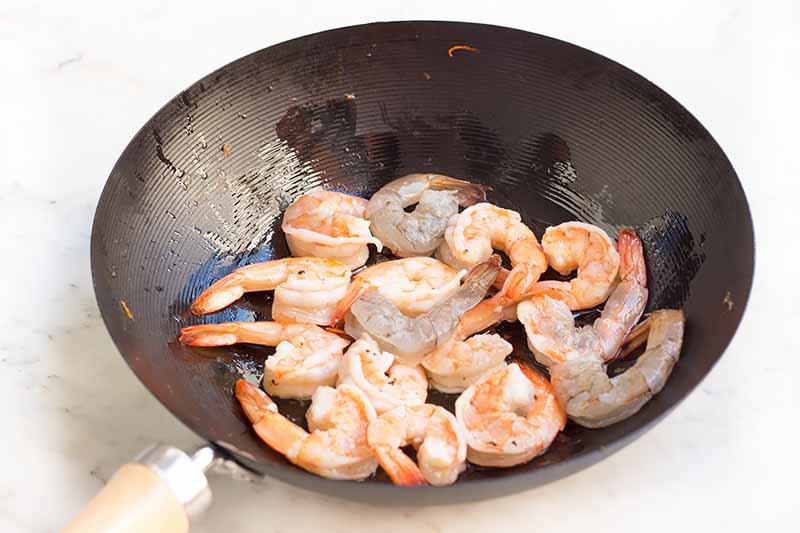
Return the wok to the heat, add another tablespoon of oil, and swirl to coat the sides. When the oil is hot to the point of smoking, add the shrimp.
Cook the shrimp fully on one side and allow them to turn pink and opaque before flipping to cook on the other side. Try not to overcook them! This will take 30 seconds to one minute on both sides.
If you opt to use pre-cooked shrimp, skip this step. They will be stirred in at the end to reheat and do not require additional cooking.
Step 9 – Combine Ingredients
Now it’s time to put all of your ingredients together.
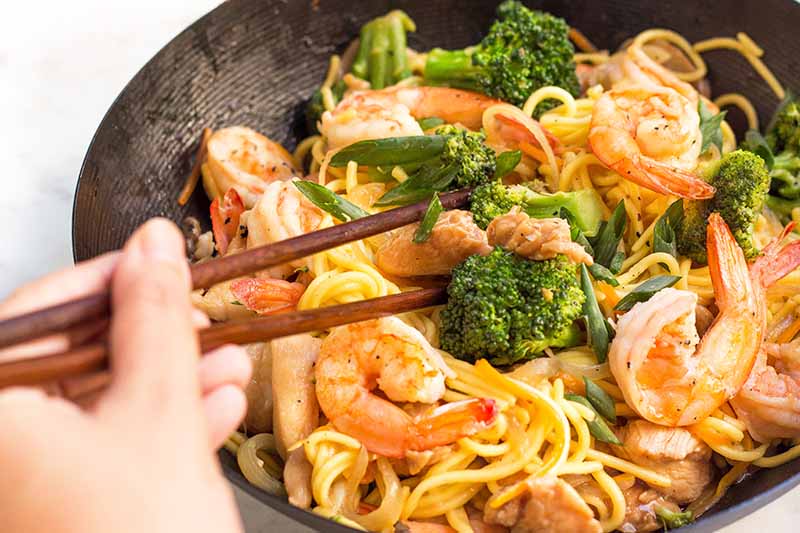
As soon as the shrimp is cooked, immediately return the chicken and vegetables to the wok and toss to combine.
Create a well in the middle of the chicken-veggie mixture and pour the sauce in, maintaining the well while stirring until it thickens.
Add the cooked noodles to the well and stir to combine. Make sure they are loosely distributed, not clumpy and sticking together.
Fold in the chicken and vegetables from the edges, toss to coat with the sauce, and serve immediately.
Ditch the Takeout Menu – Make Your Favorite Dish at Home
The next time you get a craving for Chinese, toss away the takeout menu – at least this time. You’ll love making our homemade lo mein in your own kitchen!
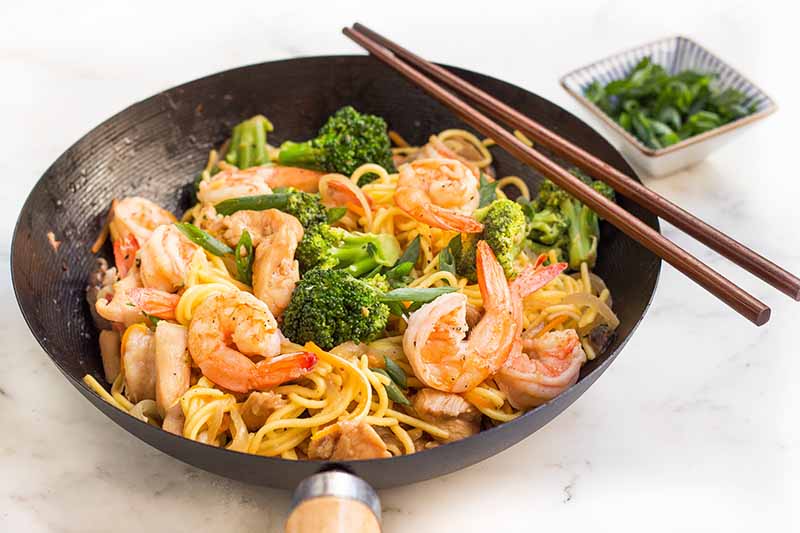
As long as you follow our advice to make sure you use the right equipment, ingredients, and prep strategies, making this meal will be so worth the effort.
You’ll soon enjoy a nice bowl of assorted veggies, chicken, shrimp, and tasty noodles – in whatever combination you decide to make tonight. If you are customizing with your own mix, use roughly 5 cups total of prepped vegetables.
There is just one other very important consideration…
If you are the type of person who believes leftover cold Chinese food is far better than when you get it hot and fresh, you and I share the same food soul.
Cold lo mein ranks right up there with cold pizza as a late-night munchie. You might consider making a bigger batch specifically to enjoy the cold leftovers.
Don’t neglect this delightful snacking opportunity!
How else do you like to cook your lo mein? What other types of ingredients do you like to use? Maybe you like a meaty beef version instead. Let us know in the comments below.
For more shrimp dishes from around the globe, try these Foodal favorites next:
Photos by Felicia Lim, © Ask the Experts, LLC. ALL RIGHTS RESERVED. See our TOS for more details. Originally published on November 24, 2013. With additional writing by Felicia Lim. Last updated on June 19, 2023.
Nutritional information derived from a database of known generic and branded foods and ingredients and was not compiled by a registered dietitian or submitted for lab testing. It should be viewed as an approximation.
About Nikki Cervone
Nikki Cervone is an ACS Certified Cheese Professional and cheesemonger living in Pittsburgh. Nikki holds an AAS in baking/pastry from Westmoreland County Community College, a BA in Communications from Duquesne University, and an MLA in Gastronomy from Boston University. When she's not nibbling on her favorite cheeses or testing a batch of cupcakes, Nikki enjoys a healthy dose of yoga, wine, hiking, singing in the shower, and chocolate. Lots of chocolate.

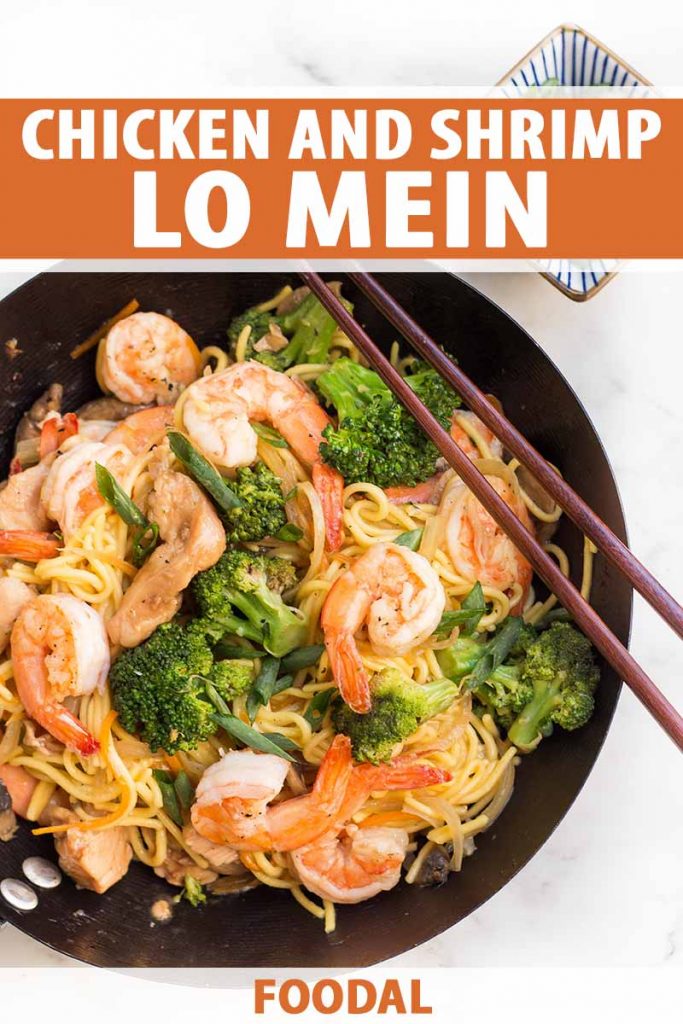
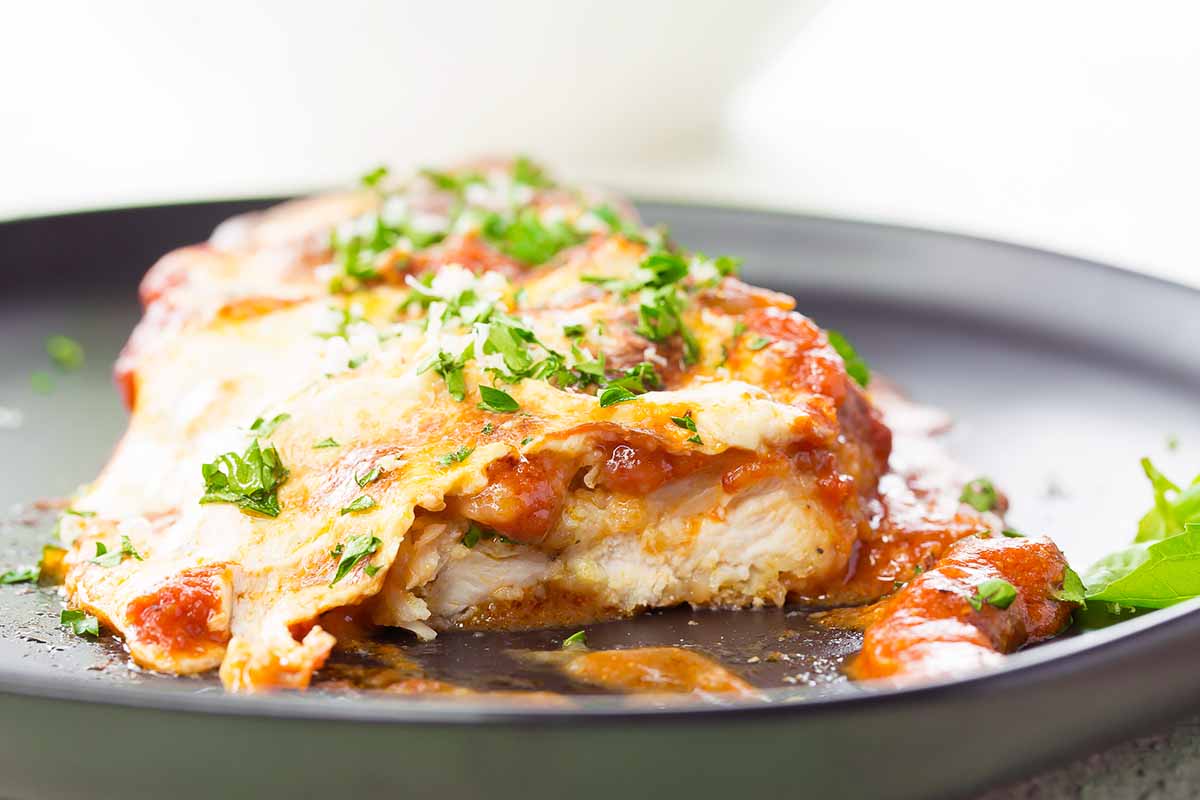
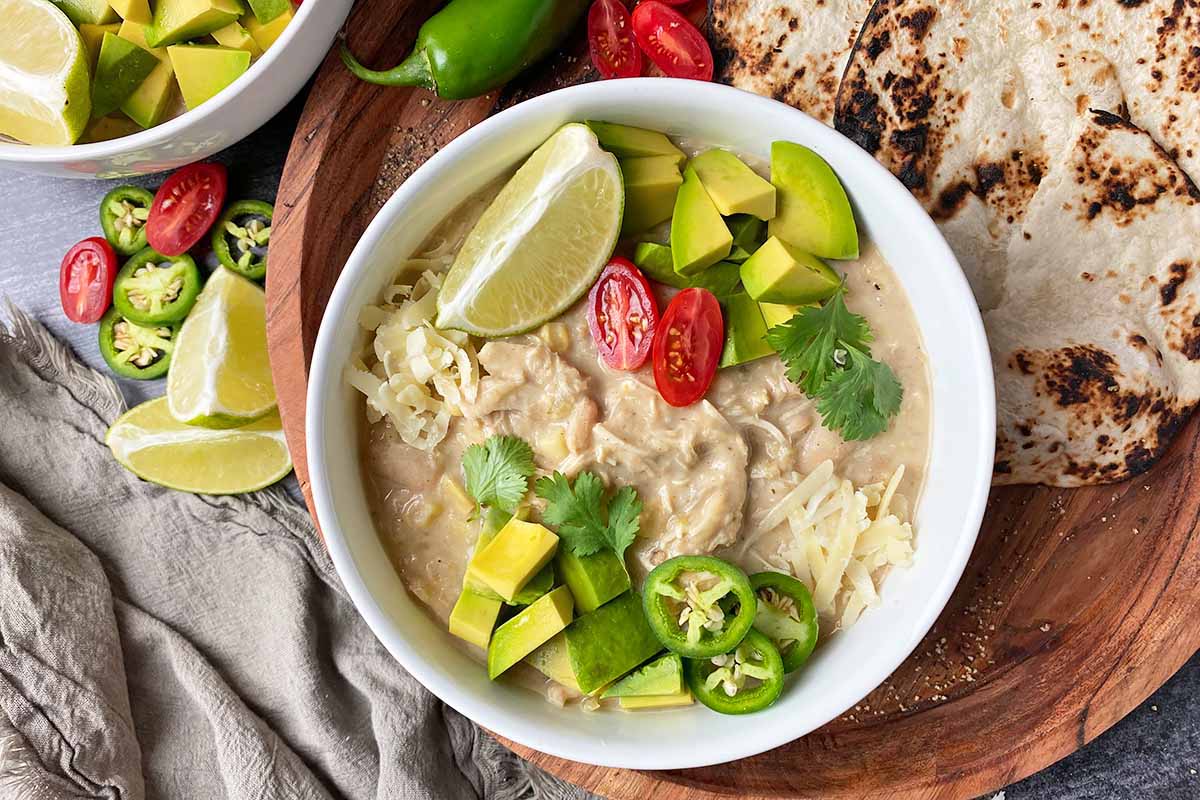
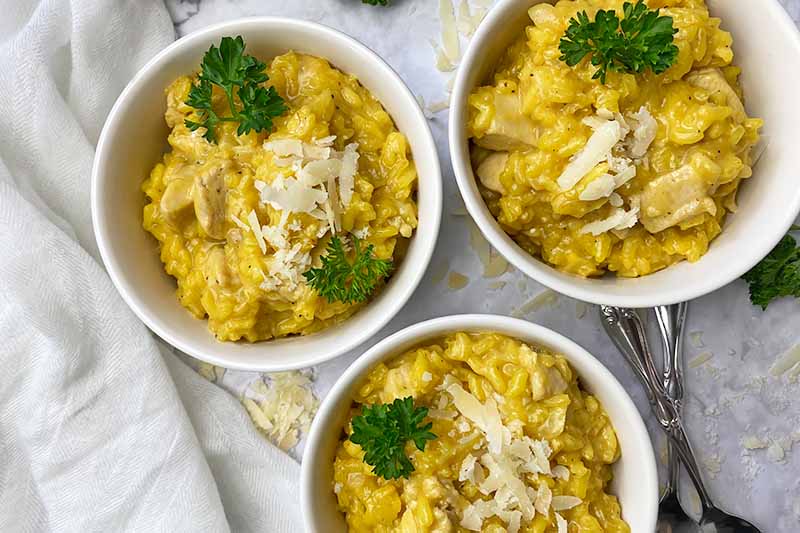
Looks fun to try out this particular dish here, but i need to budget {ahem!}…groceries and all plus i need motivation in the picture of friends…then i believe am good to go..if am allowed the page has been bookmarked for a tryout…once i succeed, i’ ll feedback, back…wish me luck 😉
This recipe sounds delicious, fresh and healthy alternative to take-out. I love the addition of fresh cut veggies. I usually get lazy and put in freezer veggies but I should really stop. They probably don’t even add any nutrition, just color. When I’m cooking for vegetarians, I like to use mushroom or vegetable stock, but I’ve noticed that it doesn’t taste the same as chicken stock.
I like the idea of the beef, chicken, and shrimp combination if I were to make this for company, but just for me, I would probably use one protein in the dish, to save on money. I recently splurged, and bought oyster sauce and rice vinegar, since I love Asian food, so I’m looking forward to making this. I’ll probably start with a shrimp version, and I’m glad you included the technique for crispy noodles, as well, because I’d like to try that variation.
I have to say, this dish looks absolutely amazing. It seems rather simple to make as well. I have a WOK, and until reading this recipe, I had no idea my skillet was what it is! Ha! I love Chinese and Asian food, and I feel this may be a much healthier way of eating Chinese. Those restaurants use all kinds of unhealthy ingredients, such as MSG. I will be sure to follow up with my review once I make this for myself. I showed this to my boyfriend and we may end up making this sometime this weekend 🙂
OMG making this for my roommate and I!!! the stereotypical ramen for dinner every night in college is absolutely no joke. This will switch it up especially on our budget
This dish sounds amazing I’m not a big chicken eater, but in this case I’m willing to make an exception. I am a nut over shrimp, and pasta. I don’t eat a lot of pasta at home we usually go out for it. Red Lobster has some awesome paste dishes.
Oh wow this recipe looks very good. Usually when I eat Chinese food I just opt for takeout, but we all know how unhealthy that is. This recipe looks especially healthy, hearty, and filling. And because I like to lift weights, eating protein and carbs are essential for me. It looks as if this recipe, tweaked slightly to add more shrimp/beef/chicken, will be perfect for hitting my protein and carb goals. I’m gonna try this one tomorrow!
Yum, I’m definitely going to give this recipe a try! I love cooking with Asian flavours, I think I’d like to try this with a little sesame oil to finish it off. It sounds like it would make good leftovers too, which is nice when you’re cooking for two people! The tips for a small kitchen are especially helpful…I live in a basement suite and our kitchen is teeny tiny; we barely any counter space.
As a huge aficionado of any food normally eaten with chopsticks, I will definitely have to bookmark this one! I usually make some variation of stir fry with rice (the variety exist in whether or not I use chicken), so it’s about time I actually branch out a bit. Thanks for the tip about the oyster sauce and rice vinegar, too! I usually stick to soy and sriracha!
It looks and sounds tasty. I’m trying to expand my repertoire, so this looks like another good addition.
I’m hoping I can find a substitution for the noodles, perhaps some spiral veggies. I know you said it has less than most, but I’m just trying to avoid pasta altogether.
Like anything else, it will be a learning experience, adjusting each dish to my “diet.” I think it will still be good.
Been looking for this recipe
I made the dish. Easy and straightforward. Good flavor. Came together quickly and smoothly. Would make again.